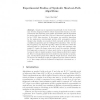Free Online Productivity Tools
i2Speak
i2Symbol
i2OCR
iTex2Img
iWeb2Print
iWeb2Shot
i2Type
iPdf2Split
iPdf2Merge
i2Bopomofo
i2Arabic
i2Style
i2Image
i2PDF
iLatex2Rtf
Sci2ools
93
Voted
WEA
2004
Springer
2004
Springer
Experimental Studies of Symbolic Shortest-Path Algorithms
Abstract. Graphs can be represented symbolically by the Ordered Binary Decision Diagram (OBDD) of their characteristic function. To solve problems in such implicitly given graphs, specialized symbolic algorithms are needed which are restricted to the use of functional operations offered by the OBDD data structure. In this paper, two symbolic algorithms for the single-source shortest-path problem with nonnegative positive integral edge weights are presented which represent symbolic versions of Dijkstra’s algorithm and the Bellman-Ford algorithm. They execute O N ·log(NB) resp. O NM ·log(NB) OBDD-operations to obtain the shortest paths in a graph with N nodes, M edges, and maximum edge weight B. Despite the larger worst-case bound, the symbolic BellmanFord-approach is expected to behave much better on structured graphs because it is able to handle updates of node distances effectively in parallel. Hence, both algorithms have been studied in experiments on random, grid, and threshol...
Related Content
| Added | 02 Jul 2010 |
| Updated | 02 Jul 2010 |
| Type | Conference |
| Year | 2004 |
| Where | WEA |
| Authors | Daniel Sawitzki |
Comments (0)

